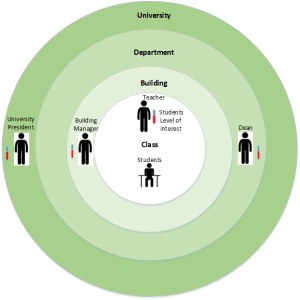This topic can be considered as part of smart city. In order to improve the teaching quality and also the students’ degree of understanding and be comfortable in the classroom, a smart classroom is suggested. Several information can be collected from the classroom and accordingly a level of students interest can be measured. This information can be used by both the students and university. From the university perspective, the students’ level of interest can be collected on the class, department, and university level, so the teacher can monitor in real time the level of interest for each individual as well as for the whole class. The department can collect on department level and so the university can collect the level of interest for the university level. Therefore, all the data can be multitude; individual, classroom, department and university level. In the figure below, we can see different layers for how to deal with the level of interest.
In the class layer, the teacher can monitor and respond to the class level of interest. The teacher might not be interested in the classroom temperature and light of intensity, but the department or university might be interested in, so these information might be collected and seen how these variables might correlated with the level of attention. The teacher is interested in the real time feedback and responds by changing his way of teaching, building manager, however, is interested in temperature, light intensity, CO2 and also in the class level of interest and responds by changing the temperature for example. The department is interested in the level of interest across several classes, and the university is interested in the level of interest across the whole university. Two universities might communicate their data and compare the level of interest in order to improve their performance by cooperation between the universities. In other words, each of them can respond to the level of interest differently, so there are different actors (teacher, manager, dean, etc.), different rolls and different levels for the same information might try to interfere to maximizing the level of interest.
From the student perspective, he/she can benefit, for example, from the level of interest in each class for the last year to know which section or class to register. The student can also get access to his own data at the end of the semester and see which course he was not paid attention. This would give him a feedback to improve himself for the next courses. The high school students can look at the university or department level of interest and choose which university or department he/she can enroll by looking at the whole level of interest.
Therefore, all of this contributed to the smart city because we have a smart education. That is what smart cities about, start getting data together and getting bigger picture and much better and more interested data.

